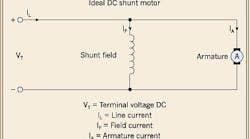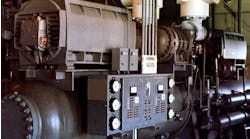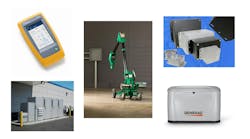Differentiating Between DC and AC Motors
By definition, an electric motor is a device that converts electrical energy into mechanical energy. An electrical signal is applied to the input of the motor, and the output of the motor produces a defined amount of torque related to the characteristics of the motor. If you think about the attraction and repulsion of the north and south poles of a bar magnet, you're on your way to understanding what has to happen inside the motor yoke. To achieve rotation, there has to be some interaction between magnetic flux produced by electromagnetism within the motor. DC motors and AC motors accomplish this task in different ways.
DC machines can be classified as self-excited, separately excited, permanent magnet (PM), and brushless. Self-excited machines can be further classified as shunt, series, and compound. Compound machines can be further classified as cumulative and differential. Cumulative and differential machines can be further classified as long shunt and short shunt. As you can see, there are a variety of electrical configurations for a DC machine. For the purpose of this article, we will stick with the series- and shunt-wound DC motor. Please note that the interconnection of the field (stationary winding) and armature (rotating winding) determine the machine's operating characteristics.
The shunt DC motor has the field winding in parallel with the armature (Fig. 1). In a parallel circuit, the magnitude of voltage drop across each parallel element is the same, while the magnitude of current through each parallel branch is a function of the impedance of the element. Please note: In a purely resistive circuit, the impedance will equal the resistance as there is no reactive component present. Shunt motors are also called constant speed motors, as they provide relatively stable speed and torque characteristics under load.
Fig. 2. The series DC motor has the field winding in series with the armature.
The series DC motor has the field winding in series with the armature (Fig. 2). In a series circuit, the magnitude of current is the same through all series elements, while the magnitude of voltage drop across each series element is a function of the impedance of the element. Series motors can develop very high starting torque and provide excellent torque characteristics under load. The drawback is speed regulation. As such, never operate a series motor without mechanical load present.
Common terms you will hear discussed with DC motors include commutator, brushes, counter electromotive force (EMF), torque, speed regulation, and speed-torque characteristic curves. When used in a motor application, the commutator is a mechanical device that properly directs current flow to the armature. By contrast, when a commutator is used in a generator application, it acts like a rectifier to convert the generated AC voltage of the machine into DC voltage. Brushes, which are usually made of carbon, are used to transition from a stationary element to a rotating element. EMF is “the difference in potential that exists between two dissimilar electrodes immersed in the same electrolyte or otherwise connected by ionic conductors.”
The terms EMF and voltage are often used interchangeably. Remember Faraday's law of magnetic induction where a magnetic field can generate an electric current? As it turns out in the case of a DC motor, when the armature rotates through the magnetic field, an induced voltage opposite in polarity to the applied voltage is created — called counter EMF. Torque is a rotational force that — in simple terms — is the algebraic product of force multiplied by distance. Speed regulation is a measure of how the speed of a DC motor decreases as more mechanical load is applied. It is a function of the armature resistance. Speed-torque characteristic curves are graphs that show the relationship between speed, as a percent of rated speed, and load torque as a percent of full rating. These are very helpful because they illustrate how applied mechanical load affects the speed and torque of series, shunt, or compound DC machines.
Fig. 3. Split-phase is one classification of single-phase motors.
AC machines can be classified as induction, wound rotor, and synchronous. Induction motors can be further classified as 3-phase and single-phase. A 3-phase induction motor can be further classified as delta wound or wye wound. Single-phase motors can be further classified as split phase (Fig. 3), capacitor start, capacitor start/capacitor run, shaded pole, repulsion start, and universal. As you can see, there are several varieties of AC motors. For the purpose of this article, we will stick with an overview of the induction motor.
The induction motor is commonly referred to as a “squirrel cage” induction motor. This is due to the fact that the rotor is constructed in a manner resembling a squirrel's cage. An induction motor has a rotor (rotating part) and a stator (stationary part) within the motor housing. When an AC signal is applied to the stator winding, a rotating magnetic field is produced. This rotating magnetic field induces a signal in the rotor, which also generates a rotating magnetic field. The interaction of these rotating magnetic fields causes rotation. This is an important principle to keep in mind because in the case of a DC motor, the magnetic field is not time varying due to the applied signal.
Common terms you will hear discussed with AC motors include frequency, synchronous speed, and slip. An AC waveform is time varying or oscillatory. This means its amplitude starts at zero, rises to some maximum value, returns to zero, falls to some minimum value, and then returns to zero. The number of times this occurs per unit of time is referred to as frequency. In the United States, this frequency is 60 Hertz or 60 cycles per second. Referring to the speed of the rotating magnetic field, synchronous speed is a function of the applied frequency and the number of stator poles in the machine. Slip is a measure of the difference between the synchronous speed of the stator field rotation and the rotor field rotation. Please note that the rotor field rotation is always slower than the stator field rotation.
Figure 4 (click here to see Fig. 4) includes power equations for AC motors. It also includes a graphical aid called the power triangle, which uses trigonometric identities to help with the analysis of power factor. Finally, some practical equations are included to calculate torque, horsepower, and efficiency.
Vidal is president of Joseph J. Vidal & Sons, Inc. in Throop, Pa.



